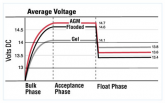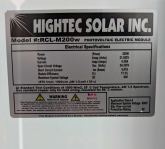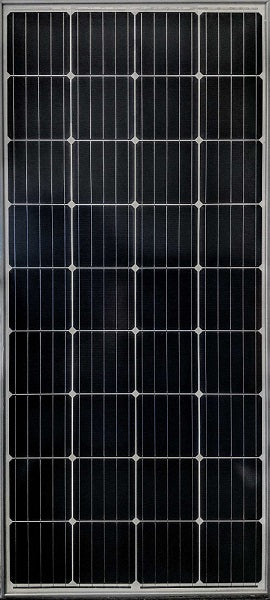You are using an out of date browser. It may not display this or other websites correctly.
You should upgrade or use an alternative browser.
You should upgrade or use an alternative browser.
Renogy DC DC Charger w/ MPPT
- Thread starter Will Prowse
- Start date
redmessengerbag
New Member
- Joined
- Mar 15, 2020
- Messages
- 41
Just connect inverter/charger to your solar/house battery and that's it. Add alternator/mppt charger to solar/house battery. You can connect multiple chargers and loads to a single battery.
I just want to confirm. With the Renogy DC dual source 50DC, I can just add either a Noco 26000 or a CTEK 25000 (AC 12v smart chargers) and connect directly to the house battery along with the Renogy?
If AC charger is charging the house battery, and there might be solar charging coming in as well through renogy and it's ok to do that?
Thanks!
RisenPhoenix71
New Member
- Joined
- Feb 29, 2020
- Messages
- 9
Hi all. I'm stocking up my Amazon cart with stuff and jumped in here to do a final run through before clicking checkout. And, that brought me to a full stop. So, my initial plan was to do the normal 4x100W PV > 40A MPPT > batteries>factory wiring>Done. Buuuuut...I'm using this on a 29ft 1999 Winnie Brave that has:
2 house batteries (FLA currently installed)
1 chassis battery (FLA currently installed)
3K Microlite genny
30A converter w/ AC panel but no inverter
30A Shore power
So, Winnie has the system set up where the house AND chassis battery charges from the alternator, the genny, and shore power. There's not enough open real estate on the roof to add more than 4x100W PV (I'm hoping that 4 will fit; might only get 2 or 3)
My Q is:
If I add this Renogy DC/DC between the solar and the current setup, can I just add an inverter that feeds the factory AC breakers? Would I just run the pos/neg wires from this to the batteries in addition to the factory setup? Or, do I need to put it inline? Given my system is 30A, do I need a 50A or would something smaller be better?
Finally, given that my Class A already has DC>DC and AC>DC charging systems, is this Renogy DC/DC + MPPT the way to go or should I stick with the 'classic' MPPT only controller?
TYIA!
(bank as wired by Winnie)
2 house batteries (FLA currently installed)
1 chassis battery (FLA currently installed)
3K Microlite genny
30A converter w/ AC panel but no inverter
30A Shore power
So, Winnie has the system set up where the house AND chassis battery charges from the alternator, the genny, and shore power. There's not enough open real estate on the roof to add more than 4x100W PV (I'm hoping that 4 will fit; might only get 2 or 3)
My Q is:
If I add this Renogy DC/DC between the solar and the current setup, can I just add an inverter that feeds the factory AC breakers? Would I just run the pos/neg wires from this to the batteries in addition to the factory setup? Or, do I need to put it inline? Given my system is 30A, do I need a 50A or would something smaller be better?
Finally, given that my Class A already has DC>DC and AC>DC charging systems, is this Renogy DC/DC + MPPT the way to go or should I stick with the 'classic' MPPT only controller?
TYIA!
(bank as wired by Winnie)

RisenPhoenix71
New Member
- Joined
- Feb 29, 2020
- Messages
- 9
.....or, instead of investing in a separate inverter, should I replace the converter with an inverter/charger and simplify the system? I'm thinking that would be the smart move; Renogy DC/DC+MPPT and replace the factory converter with a new inverter/charger. Thoughts?
RisenPhoenix71
New Member
- Joined
- Feb 29, 2020
- Messages
- 9
...on third thought; holy crap! The inverter/charger option is outrageously expensive! I think I'll stick with manually turning on the inverter when need and spend the extra $1000 on batteries or something.
The other questions still remain though ;-)
The other questions still remain though ;-)
RandyP
Solar Enthusiast
- Joined
- Sep 21, 2019
- Messages
- 742
Yea, it's expensive to go the inverter/charger direction. The charger replaces the converter (120v ac to 12v dc) you may already have. But if you see a need for a 3KW ac load in your 30A 110V / 12V camper power setup, a 3KW inverter might be a good choice. And getting an inverter charger at 3KW will provide more charging ampacity then most converters found in campers will provide. LiFePO4 batteries can be charged at 1/2 C in most cases. Some can charge at even higher ampacities. 1/2 C for a 100AH LiFePO4 battery is 50A. If you have three in parallel, that's 150A charging rating. Quick charging is a plus for LiFePO4 batteries compared to lead acid. So if your charger will do 125A charge with three 100AH Li batteries, and they start off with a 40% low SOC, you can get them to 100% SOC in 1.5 hour. Having the inverter/charger in one unit saves space, and in a pickup camper, space for the electrical system is at a premium.
Last edited:
RisenPhoenix71
New Member
- Joined
- Feb 29, 2020
- Messages
- 9
The only thing that would need 30 amps would be the AC unit, and I wouldn't try to run that off of the bank anyway. There's a microwave, lights, vent fan x1, and the fridge is a norcold 2 way so the only need for AC there would be if there was no propane. And, since this is a V10 Ford, if there is a world with no propane, there's no fuel or fluids eitherYea, it's expensive to go the inverter/charger direction. The charger replaces the converter (120v ac to 12v dc) you may already have. But if you see a need for a 3KW ac load in your 30A 110V / 12V camper power setup, a 3KW inverter might be a good choice. And getting an inverter charger at 3KW will provide more charging ampacity then most converters found in campers will provide. LiFePO4 batteries can be charged at 1/2 C in most cases. Some can charge at even higher ampacities. 1/2 C for a 100AH LiFePO4 battery is 50A. If you have three in parallel, that's 150A charging rating. Quick charging is a plus for LiFePO4 batteries compared to lead acid. So if your charger will do 125A charge with three 100AH Li batteries, and they start off with a 40% low SOC, you can get them to 100% SOC in 1.5 hour. Having the inverter/charger in one unit saves space, and in a pickup camper, space for the electrical system is at a premium.
Perhaps a 2k pure sine and a newer converter + this DC DC mppt?
Guess I really only need the 1500 watt dumb inverter that I currently own to run some plugs and the refer in an emergency. I could care less about the microwave. I would like to charge a laptop and power up some ham stuff if needed though
boboxx
New Member
I have a Kisae Abso DMT-1230 and a SW-1220 inverter and I really like them. They have a good selection of products.
Sgt Raven
Solar Addict
- Joined
- Feb 17, 2020
- Messages
- 1,079
I have the DMT-1250 sitting on my workbench waiting on my battery cells, cables and solar. Getting everything together pretty quick now. Started planning out this build a few years ago. Finally got the money. When I first started thinking about it, I was going to have to use all separate components. Since then companies have come out with the combo units and the prices have been dropping fast.I have a Kisae Abso DMT-1230 and a SW-1220 inverter and I really like them. They have a good selection of products.
So I did a little research on charging profiles, let me know if anyone disagrees.
I have dual AGMs for starter batteries, and found this info on AGMs from two different sources:
6 cells x 2.4v = 14.4v
6 cells x 2.25v = 13.5v
 www.westmarine.com
www.westmarine.com

For LiFePO4:

 battlebornbatteries.com
battlebornbatteries.com
 community.victronenergy.com
community.victronenergy.com
So it looks like an AGM profile is close enough to (or below) that to of LiFePO4, which hopefully means the Renogy won't overcharge the AGM when set to Lithium mode. Of course without measuring, we don't know exactly what charge profile Renogy is providing, but I don't foresee it causing any damage.
I have dual AGMs for starter batteries, and found this info on AGMs from two different sources:
Absorbent Glass Mat (AGM) Battery Information - Battery University
Learn what differentiates Absorbent Glass Mat (AGM) batteries from other lead acid battery types
batteryuniversity.com
As with all gelled and sealed units, AGM batteries are sensitive to overcharging. A charge to 2.40V/cell (and higher) is fine; however, the float charge should be reduced to between 2.25 and 2.30V/cell (summer temperatures may require lower voltages).
6 cells x 2.4v = 14.4v
6 cells x 2.25v = 13.5v
Selecting a Battery Charger for Your Boat | West Marine
West Marine is committed to outfitting your life on the water. With over 250 store locations, 100,000 products in stock, and knowledgeable Associates, trust West Marine for your boating, sailing, fishing, or paddling needs. Shop with confidence - get free shipping to home or stores + price match...

For LiFePO4:

The Basics of Charging LiFePO4 Batteries
Click here to read all about charging your LiFePO4 batteries and the recommended charging parameters from Battle Born Batteries!
 battlebornbatteries.com
battlebornbatteries.com
We recommend a bulk and absorption voltage of 14.4V. A float is unnecessary, since Li-ion batteries do not leak charge, but a floating voltage under 13.6V is fine.
LiFePO4: Too early to Float! - Victron Community
Absorption voltage 14.4V, max. Time 6h, float voltage 13.5V
So it looks like an AGM profile is close enough to (or below) that to of LiFePO4, which hopefully means the Renogy won't overcharge the AGM when set to Lithium mode. Of course without measuring, we don't know exactly what charge profile Renogy is providing, but I don't foresee it causing any damage.
Sgt Raven
Solar Addict
- Joined
- Feb 17, 2020
- Messages
- 1,079
If I understand the way the Renogy is programmed. It will only start charging the starting batteries, once the house batteries are full.So I did a little research on charging profiles, let me know if anyone disagrees.
I have dual AGMs for starter batteries, and found this info on AGMs from two different sources:
.....snip........
So it looks like an AGM profile is close enough to (or below) that to of LiFePO4, which hopefully means the Renogy won't overcharge the AGM when set to Lithium mode. Of course without measuring, we don't know exactly what charge profile Renogy is providing, but I don't foresee it causing any damage.
Looking at the AGM charging specs, I wonder if my alternator's regulator is charging them the right way. My truck came stock with FLA batteries, so I would think the stock charging profile would be for FLA batteries.....
What are you guys looking at for panels out there?
I've pulled up a few data sheets so far, and the Grape Solar 180w seems to provide a good cost/performance/space ratio. Helps that you can get these shipped for free from a bunch of places as well.
It's listed at 24.06v open-circuit voltage.
Any others?
I've pulled up a few data sheets so far, and the Grape Solar 180w seems to provide a good cost/performance/space ratio. Helps that you can get these shipped for free from a bunch of places as well.
It's listed at 24.06v open-circuit voltage.
Any others?
RandyP
Solar Enthusiast
- Joined
- Sep 21, 2019
- Messages
- 742


Hightec Solar 200W 36 Cell 12V Nominal Solar Panel - 5 Busbar - UL Listed
Description HIGHTEC SOLAR 200W 36-cell 12V nominal solar panel is a photovoltaic module designed to convert sunlight into electrical energy. This Solar panel has a power rating of 200 watts. This indicates the maximum amount of power the panel can generate under ideal conditions, typically full...
Sgt Raven
Solar Addict
- Joined
- Feb 17, 2020
- Messages
- 1,079
They have a few of them on ebay, that are 225W panels, but the extra 25W is going to cost more.....View attachment 9603

Hightec Solar 200W 36 Cell 12V Nominal Solar Panel - 5 Busbar - UL Listed
Description HIGHTEC SOLAR 200W 36-cell 12V nominal solar panel is a photovoltaic module designed to convert sunlight into electrical energy. This Solar panel has a power rating of 200 watts. This indicates the maximum amount of power the panel can generate under ideal conditions, typically full...www.continuousresources.com
Sgt Raven
Solar Addict
- Joined
- Feb 17, 2020
- Messages
- 1,079
I've seen them t $320 for 2 not that long ago. pair of 180Ws even cheaper... Just a guess, they build them and then see what to rate them at, depending on the cells they get. The 225W go for almost a $100 more per pair. But if you have limited space and want maximize your production, ya gotta pay for it..200W, $185 at the link I posted. In the past I have seen a few lower prices.
RandyP
Solar Enthusiast
- Joined
- Sep 21, 2019
- Messages
- 742
The 300+ Watt residential solar panels are a little bigger. If they will fit on your vehicles roof, I think they are the way to go with an MPPT controller.I've seen them t $320 for 2 not that long ago. pair of 180Ws even cheaper... Just a guess, they build them and then see what to rate them at, depending on the cells they get. The 225W go for almost a $100 more per pair. But if you have limited space and want maximize your production, ya gotta pay for it..
Sgt Raven
Solar Addict
- Joined
- Feb 17, 2020
- Messages
- 1,079
Since this is the Renogy DC-DC/MPPT thread, you're stuck at the 25V Solar input limit..... That is one of the reasons I went with Kisae for mine, it can do 45V.The 300+ Watt residential solar panels are a little bigger. If they will fit on your vehicles roof, I think they are the way to go with an MPPT controller.
Amazon dropped the Grape Solar 180W panels to $299/pair, I'll probably go w/ these unless something really compelling pops up in the next couple days.
Vmpp is 19.67v and Voc is 24.06v, which is within spec.
Impp of 9.15A means you'll max out at 3 panels for this charger, but for a van, that's probably the most you'll fit on the roof anyways?

Vmpp is 19.67v and Voc is 24.06v, which is within spec.
Impp of 9.15A means you'll max out at 3 panels for this charger, but for a van, that's probably the most you'll fit on the roof anyways?

Similar threads
- Replies
- 16
- Views
- 647
- Replies
- 6
- Views
- 377
- Replies
- 1
- Views
- 611
- Replies
- 0
- Views
- 93



